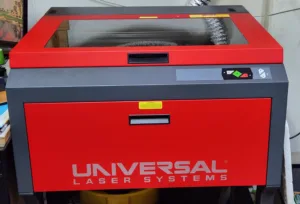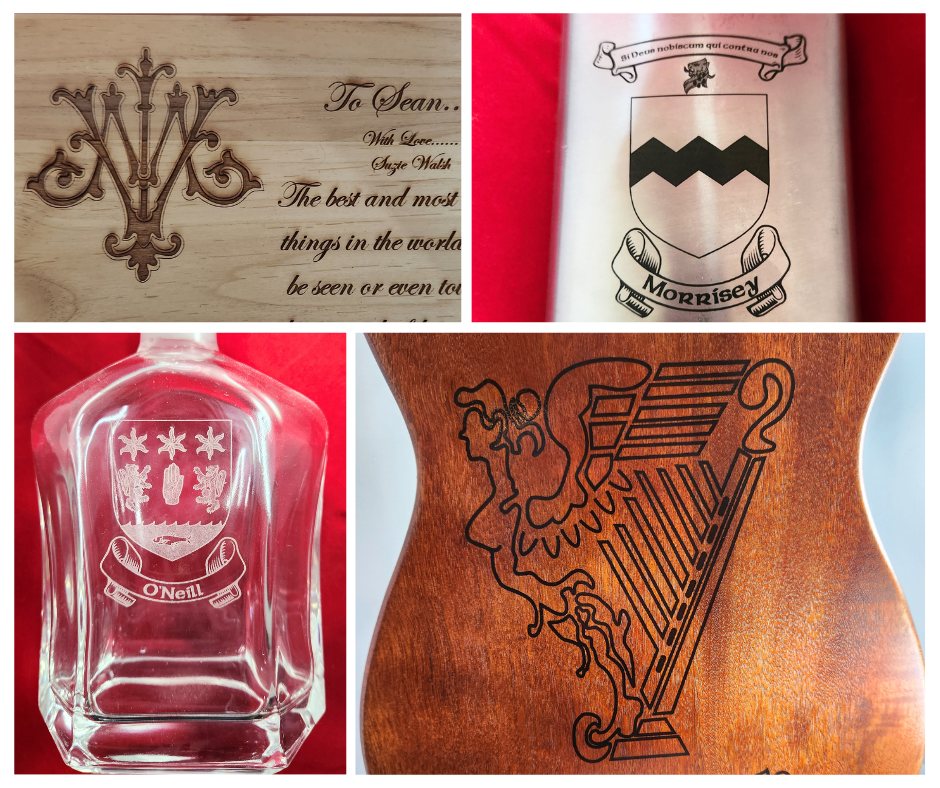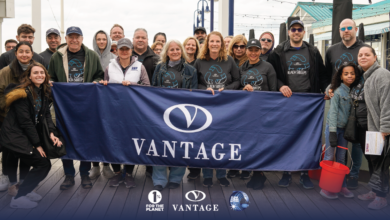Celtic Heritage Meets Laser Engraving
Virginia-based Celtic Tides celebrates heritage and culture through laser engraving
Even before owning an engraving business, Scotland-born John Morman was no stranger to lasers. A British Royal Navy veteran, Morman worked as a mechanical engineer for 34 years where he gained extensive knowledge of industrial lasers within the fabrication industry. With this knowledge in mind, in 2003, Morman’s brother-in-law Mike Esler approached him about his recommendations for sandcarving equipment.
Esler, owner of Irish Eyes, a Fredericksburg, Virginia-based embroidery shop, was looking to expand at the time and wanted Morman’s opinion. As Mike rented within a historic building with limits to the physical changes that could be made, Morman instead recommended going the laser engraving route.
From there, Morman began researching the early 2000s laser engraving market for appropriate equipment for his brother-in-law. After six months of research, he gave Esler his recommendation — who then decided to reinvest within his existing embroidery business.
“Of course, by that time, I had caught the bug,” says Morman. After all that research, John and his wife, Mary Jo Morman, took the plunge and bought themselves a 30-watt Universal Laser engraving machine.

Getting started
Living in San Diego, California, at the time, John set up shop in their garage and began work for their first retail customer, Irish Eyes. Once that was established, they began searching for more clientele.
“We knew there was a Celtic store on Coronado Island, and we knew the people really well — we had been customers of theirs for years,” explains John. “So, I did some work with their surname.” He then engraved the owner’s clan crest and coat of arms on glassware and plaques, as well as laser marking on stainless steel and pewter pieces.
He continues, “And I took it over to them and said, ‘Here’s what we’re doing. If you’d like us to do some stuff like this, you’re welcome to, and you have these as display pieces. If you’re not interested, it didn’t cost me very much, and you’ve got a Christmas present.’”
From there, the owners of the Celtic shop agreed to work with them. In addition, the shop also did many Celtic festivals/highland games and asked John and Mary Jo to travel with them to promote the engraved products. “And we trundled along quite happily like that for the better part of two years,” John says.
During that time, John and Mary Jo also conducted self-promotion by visiting different Celtic stores in the area as well as by looking at Celtic-specific publications and mailing fliers. They also attended a major Celtic buying show where they picked up more clients.

Relocation and starting fresh
However, by this time, many of John’s clientele were leaving California, and Mary Jo’s full-time job was ending. “It came to the point that we realized we were going to have to relocate,” explains John. “We figured we were faced with at least a location change, and we thought we might as well make a complete change.”
He told his brother-in-law, who mentioned that there was a Celtic store in Lexington, Virginia, he did embroidery work for that was getting ready to retire and sell. John and Mary Jo visited Lexington in late 2004, fell in love with the town, decided to relocate across the country, and bought the store — named Celtic Tides — in early 2005.
“The store itself was existing, but it really was on its last legs,” remarks John. “The owners had lost complete interest in running the store, there was very little inventory, and the community had basically lost faith in the store.”
John and Mary Jo decided to make the store into a broad-based Celtic shop, expanding the old inventory with jewelry, grocery items, custom apparel (supplied by Elser), and, of course, engraved products.
“We just kept the store name,” John says. “We kind of think it reflects both the waves of Scotts, Irish, and Welsh immigrants that moved over here, and hopefully evokes the memories of people who have been to Scotland and Ireland who remember seeing the tides coming in on the islands and cliffs.”
They also made the decision to stay open seven days a week — including Sundays. “At that time, we were one of the very few businesses in town that was open on a Sunday,” explains John. “But we had to get people to realize that we were there, and we were serious about running the store. We had to restore confidence in the community.”
Ups and downs
Although they had relocated across the country, John and Mary Jo didn’t have much issue getting the new business established. “Everybody made us very welcome, and we had customers coming in right off the bat,” states John.
He continues, “One of the things the previous owners told us was that they did a couple of local festivals. So, we went along to those couple of festivals. And to cover for periods where the store got seasonably slow, we grew to about six festivals a year.”
However, in 2008, the financial crash hit. “We realized that continuing on with festivals, and in fact doing more festivals, was the only way at that point we could see the store surviving,” John says. “Up until COVID, we had grown our festival commitment to 26 festivals a year — most of which were weighted to the second half of the year. So, on average, we were away from home every other week.”
Then the COVID-19 pandemic hit. “We survived with the store through the first part, and as things began to open back up, we became a location for people to come to,” John says. In addition, as John and Mary Jo got back into festivals, they started to attract customers who were coming up from neighboring states. “So, our location was a big help once people knew we were out there,” explains John.
The business continued to rebound and grow from there. “Last year, we had our best Christmas season ever — about 30% of that being our engraving products.” So, from essentially nothing in the store when we first opened here, our engraving business has grown to be between 35% to 40% overall.”

The shop expanded into doing jobs for local businesses and universities, as well as churches, the local police department, and the fire department. “Those have really helped us cement the engraving to the point where we had to replace our first engraver,” explains John.
Then, at the beginning of 2022, John and Mary Jo looked at how their business was running and decided to add a second machine. Now, they plan to cement the growth they’ve seen coming out of the pandemic and scale down the number of festivals they attend. “We’re 20-some years older now than when we moved here, so the festivals are becoming less attractive only because there is a lot of physical work involved,” John says.
Advice to new businesses
With over 20 years of experience in the engraving business, John offers some words of wisdom for new businesses starting out within the custom graphic industry:
1. Get involved in your community
“Getting involved in your community can be a huge bonus for your business — if you’re not already,” offers John.
John and Mary Jo have been very active within their community, working with local businesses and organizations — and even playing the community’s Santa and Mrs. Clause. “The most rewarding aspect of getting involved in the community has been exactly that,” John says. “The closeness of the community is fantastic here.”
In addition, three years ago, John was named small businessperson of the year by the local chamber of commerce. “You don’t do these things for the pats on the back and hoping someone’s going to walk in from those events and offer you business,” John says.
2. Do your homework
For those looking to get started in engraving, John stresses doing your homework beforehand.
“Be sure that things like safety, both personal and customer, are at the top of your list,” advises John. “If you’re going to be doing things like plastics, you need to be aware that the exhaust fumes are not only very corrosive for your machine but also toxic.”
John also stresses learning the limitations of your machine.
“Don’t be prepared to take on anything,” he warns. “If it’s a physically big job, make sure it’s going to fit on your machine. And you should also never override the interlocks — it’s not a good idea.”
In addition, he also recommends contacting other shops that do what you would like to do and asking for information and advice from them, as well as reading trade magazines. “There are a lot of things that you might not immediately think of,” he explains.
3. Look for new opportunities
John also emphasizes the importance of looking for opportunities through new markets.
“I can’t stress it enough — don’t get tired of looking for potential customers. They’re not going to walk in and look for you because they don’t know what you do,” he explains.
He recommends that, once you get into the groove of running your business, start looking for opportunities with your local school district, businesses, farmer’s markets, community fairs, etc. and brainstorm how you can expand your services to meet their needs.
4. Be ready for the long haul
Finally, John recommends preparing yourself for the long haul of the ever-expanding journey. He advises that businesses be prepared to take the time to learn and experiment. While suppliers are great resources, he stresses the importance of gaining experience and learning for yourself.
“You never know everything; there’s always more to learn,” John says. “You’ve got to be prepared for the learning curve — and the learning curve never stops. It gets narrower and less steep, but you’re never done with the learning.”





